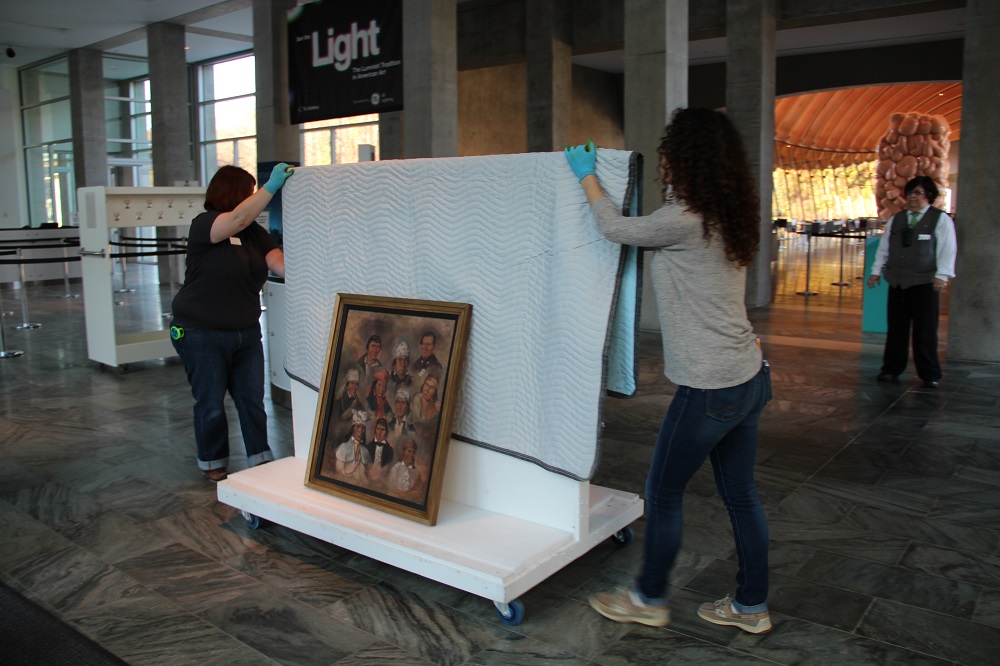One of the first things you learn when you come to work at Crystal Bridges is “Art has the right-of-way.” When our preparators are moving artworks into or out of storage, or across public spaces, mere mortals step aside. As the prep team ramps up to begin the reinstallation of our Twentieth-Century Art Gallery, we mortals on staff are prepared to “take the wall” quite a bit in the precious few hours of each day before the Museum opens to the public, and especially on Tuesdays when the gallery space belongs to the preparators and curators exclusively. But with so much art movement to be done, it’s possible guests will get a peek at the action as well: here, Associate Registrar Victoria Perdomo gives us a look at what it takes to get art on the move. —LD
Some of you might have noticed in your most recent visit to the Museum that some of your favorite paintings have moved. They might not have gone far, maybe only a few feet in some cases, but none the less they’ve found new homes.
As a registrar, one of the questions I get most often is how much time goes into moving a piece of artwork. It can’t be that cumbersome right? Just center the painting on the wall, put up a few nails, make sure its level—you’re done.
Well yes and no. The skill and precision it takes to move art is akin to that of a Jedi shooting a torpedo into the heart of the Death Star. It’s a skill that is constantly honed and perfected, and requires planning and forethought before an object is even touched.
The amount of time and planning that accompanies the movement of art can vary depending on the task at hand. In the case of a one-on-one swap, several days, or maybe even a week of planning will take place. For larger projects such as the turnover of an entire gallery, an incoming exhibition, or the movement of a complex object such as sculpture, several months of planning and prep work go into ensuring the safe movement of art through the Museum.
There are many methods of transporting art: paintings carts (for holding framed works upright), padded tables for works that must remain flat during transport, and padded carts for sculpture. For oversized, heavy objects, pallet jacks, lift tables, or a gantry (a support system with legs on two sides and a cross-bar support between)are used.

Preparators use a gantry to install “Atala and Chactas,” by Randoplh Rogers, 1854, in the Colonial and Nineteenth-Century Art Gallery.
Our dedicated team of preparators spend time making a thorough examination of the object that needs to be moved in order to determine the best manner of transport. The preparators talk through each stage of the movement to ensure that everyone handling the object is on the same page and working together as one unit.
Normally, this complex ballet of coordination, skill, and strength is executed behind closed doors away from the public. However, some art movements cannot be completed in the hours before the Museum opens, allowing guests a quick glimpse at the behind-the-scenes action.

In installing Ursula Von Rydingsvard’s monumental wall sculpture, “Unraveling,” the prep team set up scaffolding and used a lift to hoist the 300-pound segments into place.
When tasked with moving art through public spaces during the Museum’s open hours, the ante is upped and it’s an all-hands-on-deck effort. While the preparators concentrate on transporting the art, registrars work in conjunction with security and our front-of-house staff to ensure the path is clear of people as well as of obstructions such as stanchions. It’s a coordinated effort that takes focus and dedication from everyone involved. I sometimes get the feeling even a Jedi like Luke Skywalker would struggle navigating a painting through the main lobby on a busy Monday morning.
As Crystal Bridges’ prepares for the task of re-installing our Twentieth-Century Art Gallery, visitors might just catch a glimpse of our talented Jedis at work! Feel the Force!






